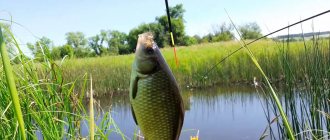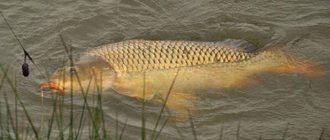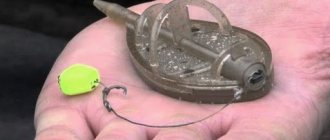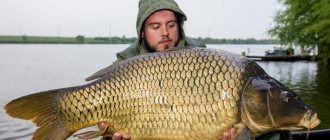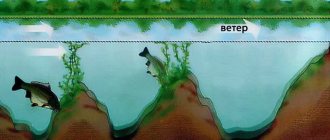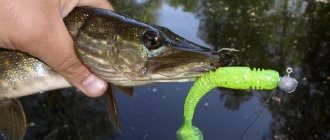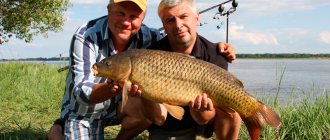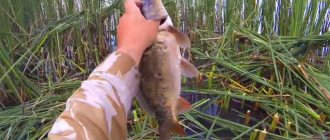Catching carp at any time of the year requires endurance, dexterity, experience and good gear from the fisherman. Although fishing for carp in the fall is the best time, since it is in the autumn that the carp begins to eat. Until mid-autumn you can count on biting both standard-sized carp and really large specimens.
But you won’t be able to just come to the pond, cast your fishing rods and wait for the giant to bite. You need to prepare good tackle that will allow you to make a good long cast and will not let you down when landing fish. After all, everyone knows what kind of resistance carp can provide, and many have already felt all its power on themselves and on their broken gear.
And, of course, you need to know where it is better to present the bait, what kind of bait, in fact, is better to offer the fish at this time of year and how to attract carp to it. We will consider all these points below in the article and you will learn all the secrets of autumn carp fishing. Of course, the best training is practice, but our theoretical information will in any case make you a more experienced fisherman and bring you closer to catching a trophy.
Best biting time
As mentioned above, autumn is a very favorable time for carp fishing; one might say, this is the best time of the year. Carp actively feed, gaining fat before winter, and this is definitely worth taking advantage of. All that remains is to figure out what time of day is best to catch carp at this time of year.
It should be understood that the water, like the air, begins to cool sharply in the fall, which also affects the activity of carp. Therefore, the deeper the autumn, the less likely it is that carp will bite at night or early in the morning. Unlike summer carp fishing, when the most promising time is from evening to dawn, in the fall everything is exactly the opposite.
Usually, in the fall, carp actively begin to bite after 9:00 and their biting continues until sunset. Of course, there are exceptions. For example, when the weather is nice and warm for several days, carp may start biting both at night and in the morning. In any case, you should focus on the warmest hours of the day, and if the difference between day and night in temperature is minimal, then you can fish around the clock.
When autumn has passed the middle, there is no point in waiting for warm days, so there is no point in going night fishing. It is enough to arrive early in the morning to have time to throw all the gear before 9 o’clock. After the sun has set or shortly before, you can safely get ready to go home.
Carp, like any other fish, can be unpredictable. It can also peck in the middle of the night in late autumn. Therefore, it is important to understand that the website rybkolov.ru talks about when the likelihood of catching carp is greater, and when a bite is unlikely. But this does not exclude other options at all.
An incident from my personal life. Summer. From evening until dawn I sat waiting for the carp to bite, but I never got it. It was getting close to lunch, so I decided to slowly get ready. I had already collected half of the fishing rods, when suddenly there was a bite. I pulled out 5 kg of carp. It was 13:00 on the clock. This seemed to be against the rules and the carp was supposed to bite at dawn or even at night, and I didn’t expect a daytime bite, but what happened happened. It’s the same in the fall – carp can surprise you.
Carp is excellently caught at the beginning of autumn and in its middle. In late autumn, carp becomes less active, but you can still continue fishing for it, although its efficiency will be much lower and there will often be days without a catch. What can I say, you can continue to catch carp even in winter.
Promising places
Another important aspect of carp fishing in the fall is the choice of location. In general, the places where carp are located in the fall are practically no different from their favorite summer camps, but here the weather can again play a role.
In normal autumn weather, carp stand in holes of more than 2-3 meters. If suddenly the weather gets better and the consistently warm weather lasts for several days, then the carp can go out to feed in the coastal zones, so on such days it won’t hurt, in addition to bottom gear, to throw several float rods at a short distance from the shore, under reed thickets.
If it’s cool outside, then carp will not be suitable in shallow water and you should fish only far from the shore, throwing the bait as close as possible to promising places.
It is very important to know that carp, although they stand in the pits in the fall, are not their feeding places. Usually the fish just rest there and often there are not one or two carp in the hole, but a fairly large school. In search of food, the carp comes out of the pits, but usually does not move far from them and stays on the edge at the exit from the pit. Therefore, the exit from the pit will be the most promising place.
A hole is especially attractive to carp if it has all sorts of cover, be it flooded trees, snags, a boat, or anything of the sort.
Parts of the reservoir where the muddy bottom turns into hard soil - sand or shell rock - work very well. Moreover, the bait should be placed on hard ground, but as close as possible to muddy ground. A school of carp actively scours the mud in search of food and will easily notice your tasty bait in a prominent place. If the bait falls into the mud, then it will be much more difficult for the carp to find it.
It may seem very difficult for inexperienced fishermen to place the bait so clearly, but it is actually quite simple to do. Usually silt or hard ground begins at a certain distance from the shore. When you pull out a bait with a sinker, pulling it through the mud you feel how hard it is going; when it reaches solid ground, pulling immediately becomes easier. All you have to do is determine at what distance the zone you need begins and try to cast as close to it as possible.
Just after casting, try not to pull the bait - let it lie where it fell, or completely pull it out of the water and re-cast it. If you reel in the bait after casting, the likelihood of carp biting will decrease.
Those areas of the reservoir that were abundant with vegetation in the summer are not suitable for carp fishing in the fall, since there is no food for carp in the withering and rotting plants at the bottom.
On warm autumn days, carp like to go out into shallow water, but as soon as the temperature drops, the carp go back to the holes. Such outputs are most often observed during the temperature peak, that is, during the warmest time of the day, which is approximately lunchtime. But at the beginning of autumn, when the water has not yet completely cooled down or has not yet cooled down at all, carp happily go out to the coastal shallows to feed both in the morning and in the evening.
If you know the reservoir and its bottom or, having pulled out the tackle, found a pearl barley caught on the tackle (a pearl barley is a river mollusk, like a mussel, only from the river), then you have found another promising place for catching carp. The fact is that pearl barley usually live in colonies, and carp really like to feed in places where such colonies are concentrated. In addition, carp really like pearl barley, but the fish is not able to crush its shell. But carp will not refuse pearl barley, peeled from the shell, and you can use it as an excellent bait.
Carp tackle
To catch carp in October, you should use reliable and strong gear that can cope with impressive jerks and withstand heavy loads. In addition, you will have to constantly re-cast the bait.
When choosing gear, you should give preference to models that provide long-range fishing and do not interfere with the passage of the fishing line along a specific route. Carp are cautious inhabitants of the depths, so the equipment should be as inconspicuous as possible. In October, a running rig is popular, as it allows you to cast bait over a considerable distance. As for the thickness of the fishing line, it is determined by the size of the expected trophy and can range from 0.25 mm (monoline), when using high-quality and balanced gear. Fishing story: Every carp is like a trough
The length of a carp rod is 2.5-3 meters for boat fishing. It is advisable to use match forms, which are characterized by increased sensitivity and allow you to respond to any bite, even the most insignificant. In addition, the tackle must be additionally equipped with a bite alarm, which will notify you of a bite that has occurred.
Carp fishing in autumn: bait
Now is the time to move on to considering baits for carp fishing in the fall. And in the fall, the carp again switches to feeding on animal baits, so catching carp during this period costs:
- dung worm;
- crawling out;
- bloodworm;
- maggot;
- boilies with animal bait flavors (worm, meat, blood, fish), etc.
In autumn, you should not offer large bait to carp. If you fished with large boilies with a diameter of 15 mm and above, then now you should give preference to boilies with a smaller diameter - up to 15 mm and, of course, the summer sweet aromas of boilies should be replaced with animal ones.
If you fished with a crawler, you probably used a whole large worm or even a bunch. Now it is better to choose smaller worms or even use half of it.
If there are no small fish in the reservoir that will eat the bait without allowing the carp to even notice it, then bait such as a bunch of bloodworms or maggots is perfect. The bloodworm can be put on a carp hook in a bunch using a special device that fixes the bloodworm on the hook with an elastic band. But if there is a lot of “trifles” on the pond, then it is better to give preference to boilies or a crawler.
Carp are caught well in the fall using a dung worm, but again, small fish can interfere with carp fishing. You can try to get out of the situation by putting a bunch of worms on the hook, but such a trick may not help and after a few minutes the “trifle” will not leave a trace of it, and you won’t even notice the bite. If there are no small fish, which is extremely rare, then no problems with catching carp should arise and a bite will definitely occur.
Using plant bait for carp in the fall is not justified; it can still work on paid reservoirs where carp are fed with such food. In general, carp almost completely switch to animal food, although, of course, there are exceptions.
Carp biting time by season
- Summer. This time of year is the most favorite for carp, since it is heat-loving and its bite improves as the water warms. Fishing in summer begins after spawning in early June and continues until early September. During the day it hides from the heat, so you should look for it at a depth of 2-5 m near underwater holes where there is cool water. He also moves into the thickets, where he calmly finds peace, food and protection from enemies.
It is better to go fishing in warm, cloudy weather, because during prolonged heat the carp eats practically nothing and waits out unfavorable weather for it. - Autumn. Fishing during this period becomes not as exciting as in summer. The water temperature drops and, accordingly, biting activity also decreases. In early autumn, it lives near thickets, snags and reeds. When the water becomes clean and transparent, the fish begins to look for places where they can hide. This type of fish prefers muddy water, where it is not visible.
Before going into hibernation, the carp begins to actively look for food for itself, so the bite during this period increases. But at the same time, the weather must correspond to his behavior.The days for successful fishing must be warm. When frost sets in, individuals of this genus most often live in pits, and if you find one, successful fishing is guaranteed.
- Winter. This is the most inappropriate period for carp fishing. It is almost impossible to attract it with bait, so it is rarely possible to return home with a trophy catch.
- Spring. Fishing begins immediately after the ice melts from the surface of the reservoir.
It should be noted that on rivers this process occurs much earlier than on closed reservoirs.After winter, carp begin to gain weight and become stronger as spawning begins soon. He actively takes any bait offered by her. When the water is still cold, its activity is not too noticeable. With each warm day, the water becomes warmer and warmer, so the carp begins to go out to the shallows, which are well warmed up by the sun's rays.
At the beginning of spring, the water is quite clear and therefore you should be very careful when catching this shy fish.
It reacts quite quickly to loud sounds on the shore, bright colors, bait and tackle. You should be quite careful.
Bait for carp in autumn
Of course, carp fishing can never do without bait. Because it is the bait that indicates to the carp that it has found your bait.
In autumn there should not be a lot of bait. First of all, before you start fishing, even before you start putting your gear in combat readiness, you must do a preliminary feeding of the fishing area. And while you are preparing your gear, the bait will slowly begin to act and attract fish.
To pre-feed carp in the fall, a few balls of bait the size of a tennis ball are enough for one tackle. Five tackles - 10 balls. When fishing for carp on a feeder in the fall, it is better to use smaller feeders than in the summer and maintain an active fishing pace, re-casting the tackle 3-5 times per hour.
The bait for feeders should be of the correct consistency - it should not spill out of the feeder immediately when it hits the water, but at the same time, it should quite actively come out of the feeder when it is already lying on the bottom.
Try to cast to the same place, then all the bait will be concentrated at one point and the likelihood of a bite will increase. You can buy bait in the store, or you can make it yourself.
In the fall, it is important not to overfeed the fish with bait, while at the same time attracting it with the aroma and tasty treats in it. It is very important that the bait contains elements of animal bait; usually they are pieces of worms or bloodworms.
When it comes to flavors or DIPs, stick to animal bait scents, saving sweet summer scents for next season. Although, on some paid reservoirs, there may be exceptions if the fish are accustomed to sweet boilies throughout the year. Use a minimum of flavorings, adhering to the rule: “less is better than more.” Otherwise, you risk not attracting, but scaring away the fish.
Bait in October for carp
For effective fishing in October, you need to find a suitable bait mixture and intensively feed the promising area. Experienced fishermen advise throwing 10-15 kg of complementary food into the water per day. In addition, it is recommended to treat the selected place for several days so that the carp will fall in love with it and stay for a long time. The prepared mixture should emit an intense aroma and contain a lot of nutritious ingredients.
Compositions based on corn, potatoes and cereals are in particular demand, due to their aromaticity and nutritional value. However, they cannot be called a universal option, because... In each body of water, fish display their gastronomic preferences in different ways. When choosing bait, the situation is exactly the same, because if in one place the carp is interested in the earthworm, then in another it is exclusively interested in potatoes. Fishing story: The difficult fate of the wise carp
Tackle for carp fishing in autumn
To catch carp, use a feeder or carp rods. The choice of gear depends on the size of the expected catch. It is quite possible to handle carp up to 2-3 kg with a feeder; if there is a chance of a larger carp biting, it is better to take a carp rod that is specifically designed for catching strong, large fish, which is carp.
If you take a feeder, then forms with 50-100 grams of dough, 3.5 meters long, are optimal. If the feeder is branded, then it should come with several tips, usually three, with different stiffnesses. To catch carp, it is better to use the stiffest tip, which will allow you to make a powerful hook so that the carp sits well on the hook after biting.
The reel must have a baitrunner and a good, reliable clutch. The size is suitable within 3000-4000 Shimano.
If we talk about carp rods, then it is better to take plug blanks 3.6 meters long. They will allow you to make a good long cast and easily cope with even large prey. More details about the carp rod and its equipment here. And, of course, do not forget that to catch fish such as carp, it is mandatory to have a landing net. Moreover, the landing net must be large and strong so that it does not fail at the most crucial moment.
